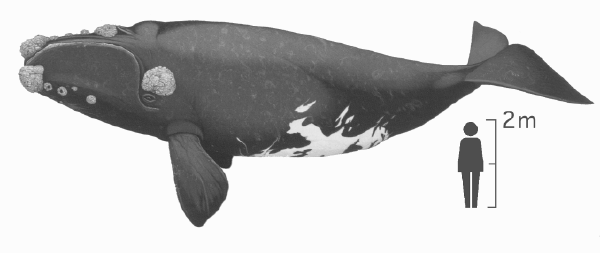The Southern Right Whale
(Eubalaena australis)
Northern Right whale
(Eubalaena glacialis)
Right Whales were regarded by Nineteenth century whalers as the 'right' whales for their industry. They were easy to approach, lived close to shore, floated when they were dead, and provided large quantities of valuable oil, meat, and whalebone.
There are only minor cranial differences between the northern and southern hemisphere species, and it is suggested that southern whales have more callosities on top of their lower lip and fewer on top of the head.

Click here for a bigger Image
Suborder: Mysticeti
Family: Balaenidae
Other Names: Black Right Whale, Right Whale (bothe species), Biscayan Right Whale (Northern Right Whale).
Right Whales are slow, lumbering, skimmer-feeders. They are surprisingly acrobatic and may be seen waving their flippers above the surface, breaching, lobtailing, and flipper-slapping. Southern Right Whales will also "head-stand", waving their flukes high in the air for up to 2 minutes. They sometimes raise their flukes at right angles to the wind and use them as sails. This allows them to be blown along through the water and appears to be a type of play as they will often swim back and do it again.
Their baleen plates are narrow, up to 2 metres long, and vary from dark brown to dark grey or black, though it can appear yellowish underwater. The baleen is used to filter out plankton and krill (small shrimp-like crustaceans) as they cruise along the surface. They seldom reach a speed of 9km/hr. and take over a month to swim the 5000 km or so distance from the sub-Antarctic waters.
Right Whales migrate to warmer temperate waters to give birth and mate. They also teach their young how to swim in the warm sheltered waters. The new-born calves have virtually no blubber to insulate them from the cold. They are fattened on rich whale milk which has a 40% fat content. This produces spectacular results and whale calves may double their weight within a week. However, there is no food in these warmer waters for the mothers, who must fast while they raise their young.
Most births occur in early winter, after which the adults begin their courtship displays of breaching, tail splashing, jostling and caressing.
Calves stay close to their mothers, suckling for a year or less and playing together. Calves learn skills they need to survive in one of our planet's great wilderness areas, the Ocean.
By the 1860's Right Whale numbers were so severely depleted that whalers could no longer hunt them profitably. From an estimated world population of 100,000 whales, 30,000 were taken from Australian and New Zealand waters alone.
Today the world population numbers about 2,000 of which 500 visit southern Australian waters to mate and breed. It is feared that the eastern American stock, now less than 300, is in great danger of extinction due to the accidental deaths of right whales involved in shipping accidents. It may never recover and it may already be doomed to extinction.
All Right whales are protected internationally under the convention for the regulation of whaling and have not been actively hunted since 1935.
| Bibliography | Whales on the Net |